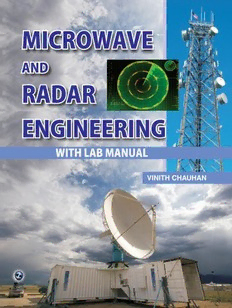Table Of ContentMicrowave
and
Radar Engineering
With Lab Manual
MICROWAVE
AND
RADAR ENGINEERING
With Lab Manual
By
VINITH CHAUHAN
[M.Tech., MBA]
Head and Asst. Prof.
Department of ECE and EIC
St. Margaret Engineering College
Neemrana, Alwar, Rajasthan
(An Imprint of Laxmi Publications Pvt. Ltd.)
An ISO 9001 : 2008 Company
BENGALURU (cid:122)(cid:122)(cid:122)(cid:122)(cid:122) CHENNAI (cid:122)(cid:122)(cid:122)(cid:122)(cid:122) COCHIN (cid:122)(cid:122)(cid:122)(cid:122)(cid:122) GUWAHATI (cid:122)(cid:122)(cid:122)(cid:122)(cid:122) HYDERABAD
JALANDHAR (cid:122)(cid:122)(cid:122)(cid:122)(cid:122) KOLKATA (cid:122)(cid:122)(cid:122)(cid:122)(cid:122) LUCKNOW (cid:122)(cid:122)(cid:122)(cid:122)(cid:122) MUMBAI (cid:122)(cid:122)(cid:122)(cid:122)(cid:122) RANCHI (cid:122)(cid:122)(cid:122)(cid:122)(cid:122) NEW DELHI
BOSTON (USA) (cid:122)(cid:122)(cid:122)(cid:122)(cid:122) ACCRA (GHANA) (cid:122)(cid:122)(cid:122)(cid:122)(cid:122) NAIROBI (KENYA)
MICROWAVE AND RADAR ENGINEERING WITH LAB MANUAL
© by Laxmi Publications (P) Ltd.
All rights reserved including those of translation into other languages. In accordance with the Copyright (Amendment) Act, 2012,
no part of this publication may be reproduced, stored in a retrieval system, or transmitted in any form or by any means, electronic,
mechanical, photocopying, recording or otherwise. Any such act or scanning, uploading, and or electronic sharing of any part of this
book without the permission of the publisher constitutes unlawful piracy and theft of the copyright holder’s intellectual property. If
you would like to use material from the book (other than for review purposes), prior written permission must be obtained from the
publishers.
Typeset at ABRO Enterprises, Delhi
First Edition : 2015
ISBN 978-93-83828-65-4
Limits of Liability/Disclaimer of Warranty: The publisher and the author make no representation or warranties with respect to the
accuracy or completeness of the contents of this work and specifically disclaim all warranties. The advice, strategies, and activities
contained herein may not be suitable for every situation. In performing activities adult supervision must be sought. Likewise, common
sense and care are essential to the conduct of any and all activities, whether described in this book or otherwise. Neither the publisher
nor the author shall be liable or assumes any responsibility for any injuries or damages arising herefrom. The fact that an organization
or Website if referred to in this work as a citation and/or a potential source of further information does not mean that the author or
the publisher endorses the information the organization or Website may provide or recommendations it may make. Further, readers
must be aware that the Internet Websites listed in this work may have changed or disappeared between when this work was written
and when it is read.
All trademarks, logos or any other mark such as Vibgyor, USP, Amanda, Golden Bells, Firewall Media, Mercury, Trinity, Laxmi appear-
ing in this work are trademarks and intellectual property owned by or licensed to Laxmi Publications, its subsidiaries or affiliates.
Notwithstanding this disclaimer, all other names and marks mentioned in this work are the trade names, trademarks or service
marks of their respective owners.
& Bengaluru 080-26 75 69 30
& Chennai 044-24 34 47 26, 24 35 95 07
& Cochin 0484-237 70 04, 405 13 03
& Guwahati 0361-254 36 69, 251 38 81
s
e & Hyderabad 040-27 55 53 83, 27 55 53 93
h
c
an & Jalandhar 0181-222 12 72
r
B
& Kolkata 033-22 27 43 84
Published in india by & Lucknow 0522-220 99 16
UNIVERSITY SCIENCE PRESS & Mumbai 022-24 91 54 15, 24 92 78 69
& Ranchi 0651-220 44 64
(An Imprint of Laxmi Publications Pvt.Ltd.)
An ISO 9001:2008 Company
113, GOLDEN HOUSE, DARYAGANJ,
NEW DELHI - 110002, INDIA
Telephone : 91-11-4353 2500, 4353 2501
Fax : 91-11-2325 2572, 4353 2528 C—
www.laxmipublications.com [email protected]
DDDDDeeeeedddddiiiiicccccaaaaattttteeeeeddddd tttttooooo
My Parents
and
My Daughter
Riddhima
Contents
Preface....................................................................................................................(xiii)
Acknowledgement...................................................................................................(xiv)
Syllabus ..........................................................................................................(xv)—(xvi)
CHAPTER 1 INTRODUCTION TO MICROWAVE ENGINEERING 1–11
1.1 Introduction...........................................................................................................1
1.2 Microwave Frequency Range .................................................................................2
1.3 Historical Resume of Microwave Engineering.........................................................3
1.4 Characteristic Features of Microwaves....................................................................4
1.5 Advantages of Microwaves.....................................................................................4
1.6 Applications of Microwaves ...................................................................................6
1.7 Low Frequencies vs Microwaves ............................................................................9
1.8 Microwave Transmission Media............................................................................10
1.9 Microwave Source...............................................................................................10
1.10 Safety in Microwaves .......................................................................................... 10
Review Questions...............................................................................................11
CHAPTER 2 MICROWAVE TRANSMISSION LINES 12–138
2.1 Introduction.........................................................................................................13
2.2 Multiconductor Transmission Lines.......................................................................14
2.3 Rectangular Waveguide........................................................................................16
2.4 Waveguide Parameters ........................................................................................20
2.5 Solutions of Wave Equation in Rectangular Waveguide......................................... 21
2.6 Expression for Phase Velocity, Group Velocity and Guide Wavelength..................35
2.7 Advantages of Having only the Dominant (TE ) Mode........................................ 38
10
2.8 Waveguide as High Pass Filter.............................................................................38
2.9 Power Transmission in Rectangular Waveguide .................................................... 58
2.10 Power Losses in Rectangular Waveguide..............................................................61
2.11 Field Patterns for Rectangular Waveguide ............................................................ 71
(vii)
(viii)
2.12 Excitation of Modes in Rectangular Waveguide ....................................................74
2.13 Comparison between Waveguide and Two-wire Transmission Line .......................78
2.14 Circular Waveguide..............................................................................................79
2.15 Why TEM Mode is not Possible in Waveguide? ...................................................91
2.16 Advantages, Disadvantages and Applications of Circular Waveguides ....................91
2.17 Field Pattern for Circular Waveguide ................................................................... 92
2.18 Methods of Excitation of Modes in Circular Waveguide........................................94
2.19 Elliptical Waveguide...........................................................................................104
2.20 Materials for Waveguide ....................................................................................105
2.21 Advantages of Waveguide..................................................................................105
2.22 Disadvantages of Waveguide..............................................................................106
2.23 Planar Transmission Lines .................................................................................107
2.24 Microstrip Line..................................................................................................110
2.25 Parallel Strip Lines............................................................................................126
Keywords..........................................................................................................132
Review Questions.............................................................................................133
Objective Type Questions.................................................................................136
CHATER 3 MICROWAVE COMPONENTS 139–215
3.1 Introduction.......................................................................................................140
3.2 S-Matrix Representation of Network..................................................................140
3.3 Advantages of S-Matrix .....................................................................................147
3.4 Waveguide Tees ................................................................................................147
3.5 Waveguide Bends, Corners and Twists...............................................................155
3.6 Hybrid Tee (Magic Tee).....................................................................................157
3.7 Rat-race Junction (Magic Ring) ..........................................................................162
3.8 Directional Coupler ...........................................................................................164
3.9 Isolators and Circulators ....................................................................................179
3.10 Circulator..........................................................................................................182
3.11 Impedance Matching Devices.............................................................................188
3.12 Microwave Attenuators ......................................................................................192
3.13 Phase Shifters...................................................................................................196
3.14 Matched Loads..................................................................................................198
3.15 Waveguide Coupling..........................................................................................200
3.16 Waveguide Transitions .......................................................................................204
3.17 Waveguide Discontinuities..................................................................................205
3.18 Slotted Line Carriage ........................................................................................207
3.19 VSWR Meter ....................................................................................................208
3.20 Wave Meter ......................................................................................................209

